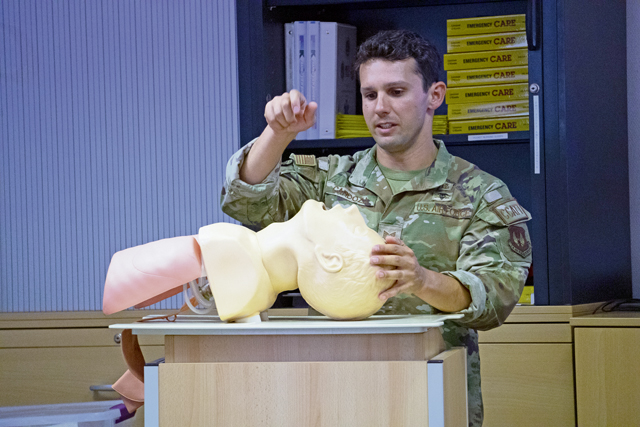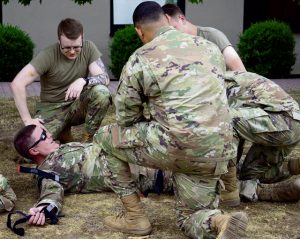
Ramstein Airmen are now able to take advantage of the Tactical Combat Casualty Care training program, which was recently implemented by the U.S. Air Force, giving multi-capable Airmen the tools to provide life-saving trauma care, both in combat, and on the home front.
Tactical Combat Casualty Care, also known as TCCC or TC3, is the new standard across the Department of Defense for first response care as a Secretary of Defense initiative. As of June 1, the TCCC program has completely replaced Self-Aid Buddy Care, also known as SABC.
TCCC is broken into four tiers: All Service Members Course, Combat Lifesaver Course, Combat Medic/Corpsman Course and Combat Paramedic/Provider Course.
Currently, only tiers one through three are published through the Defense Health Agency. All service members are expected to be certified in the tier one component by April 2023. Depending on a member’s Air Force Specialty Code, members may need to certify in additional tiers by August 2023.
Members will be taught five life-saving skills through classroom instruction and hands-on training. TCCC instructors emphasize the importance of the use of the MARCH algorithm: Massive bleeding, airway, respiration, circulation and hypothermia/head injuries. MARCH provides the order in which the life-saving skills should be applied. This also affords a better opportunity to work as a team to make sure combat injuries are treated both quickly and properly.

“In the all service members course, we teach you five life-saving skills,” said Master Sgt. Caige Chapman, 86th Medical Squadron Maternal Services flight chief. “Although we say they are basic skills, when you look at a maintainer, who is going to be first at the point of injury if something were to occur on the flightline, them being trained to the standard affords them the knowledge to use those learned skills until medical professionals are able to show up and do their jobs.”
TCCC aims to help close the gap of preventable deaths to the goal of zero by teaching the total force the five life-saving skills, as well as applying those learned skills with hands-on training.
“Being someone who has been around Self-Aid Buddy Care and the skills you learn, it was like a check-box that was missing the hands-on piece,” said Tech. Sgt. Nova Benington, 86th Medical Squadron Podiatry Clinic noncommissioned officer in charge. “The performance piece is what prepares you to use those five life-saving skills to get your patient to the next echelon of care; to ultimately get them home.”
Unlike SABC, TCCC will not be a yearly requirement. With the exception of medical AFSCs, service members will need the initial TCCC course, and then would not need to renew their certification until the member is due for a permanent change of station, or has been tasked with a deployment.
Another benefit to TCCC is the team aspect MARCH algorithm – massive bleeding, airway, respiration, circulation, hypothermia – provides. This will be used by all tier levels for point of injury care.
“Something Tech. Sgt. Bennington and I would like to highlight is that this can’t be a one and done mindset when it comes to this care,” said Chapman. “Even if you decide to grab a tourniquet or combat gauze and integrate it into training day, staying ready with these skills is something that needs to be implemented. Staying competent in these skills will save lives.”


